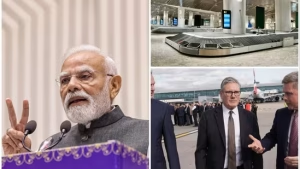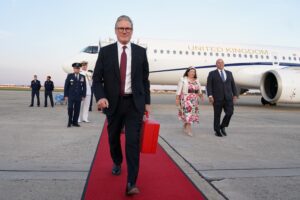Mumbai – Prime Minister Narendra Modi‘s two-day visit to Mumbai commenced on October 8, marking a significant milestone for the city’s infrastructure development. The PM Modi Mumbai visit will witness the inauguration of several landmark projects that promise to transform urban mobility and connectivity in the Mumbai Metropolitan Region.
The visit includes the inauguration of Mumbai’s first fully underground metro corridor, the Navi Mumbai International Airport, and a crucial bilateral meeting with United Kingdom Prime Minister Sir Keir Starmer scheduled for October 9.
Mumbai’s First Fully Underground Metro Corridor

A highlight of the PM Modi Mumbai visit is the inauguration of the final 10.99-kilometre stretch of Metro Line 3, connecting Acharya Atre Chowk to Cuffe Parade stations. This completion will make Mumbai’s first fully underground metro corridor operational across its entire 33.5-kilometre route.
The Aqua Line, as Metro Line 3 is known, runs from Cuffe Parade in South Mumbai to Aarey JVLR in Goregaon, entirely underground. Two segments—Aarey JVLR to Bandra Kurla Complex (BKC) and BKC to Acharya Atre Chowk—are already operational. During the PM Modi Mumbai visit, the inauguration of Phase 2B will add 11 new underground stations, improving connectivity to South Mumbai’s heritage precinct, key government offices, and business districts.
Massive Investment in Urban Infrastructure

The final stretch has been constructed at an estimated cost of ₹12,195 crore, while the complete Aqua Line represents a total investment of over ₹37,270 crore. This substantial expenditure underscores the project’s significance in Mumbai’s public transport landscape.
According to official statements, “As Mumbai’s first and only fully underground metro line, this project is set to redefine commuting across the Mumbai Metropolitan Region, offering a faster, more efficient, and modern transit solution for millions of residents.”
Also Read: UK India Visa Rules Unchanged: Starmer Confirms No Relaxation Despite Trade Deal
Enhanced Connectivity and Integration
Phase 2B of the metro line provides integration with the Central Railway at Mumbai CSMT and with the Western Railway at Mumbai Central and Churchgate. This enhanced connectivity will improve access to financial hubs like the Reserve Bank of India and Bombay Stock Exchange, as well as business districts such as Fort, Nariman Point, and Kalbadevi.
The complete Aqua Line, with 27 stations, offers direct connectivity from Cuffe Parade to Aarey JVLR, including access to Chhatrapati Shivaji Maharaj International Airport from South Mumbai. The corridor is expected to improve access to half a dozen business hubs, 30 educational institutions, 13 hospitals, 14 religious sites, and 30 recreational centres.
Environmental and Social Impact
The Mumbai Metro Rail Corporation Ltd stated that Metro Line 3 is expected to reduce the suburban railway load by 15 percent. The project will result in impressive environmental benefits, including 3.54 lakh litres of fuel saved daily and 6.65 lakh fewer vehicular trips, helping reduce traffic congestion and noise pollution.
Over 23,000 trees have been planted under compensatory plantation efforts, with mangrove restoration projects underway. The project also involved the rehabilitation of 1,941 families in ownership flats and 733 families in temporary accommodations.
Engineering Marvel and Record-Breaking Construction
In a national first, the Aqua Line construction saw the simultaneous deployment of 17 Tunnel Boring Machines—a record in Indian underground construction. Once fully operational, commuters will travel between Cuffe Parade and Aarey JVLR in approximately one hour, a journey that currently takes between one to two hours depending on road traffic.
The line is expected to cater to 13 lakh commuters daily, providing seamless metro access between South Mumbai and the northern suburbs.
Mumbai One Mobility App Launch
During the PM Modi Mumbai visit, the Prime Minister will also launch “Mumbai One,” a common mobility app integrating various public transport systems across the Mumbai Metropolitan Region. This digital initiative of PM Modi Mumbai visit aims to streamline urban transportation and enhance commuter convenience.
Navi Mumbai International Airport Inauguration
At approximately 3:30 pm on October 8, another crucial component of the PM Modi Mumbai visit will unfold with the inauguration of Phase 1 of Navi Mumbai International Airport. Built at a cost of around ₹19,650 crore, the airport represents India’s largest Greenfield airport project developed under a Public-Private Partnership model.
The Navi Mumbai International Airport will serve as the second international airport for the Mumbai Metropolitan Region, working alongside Chhatrapati Shivaji Maharaj International Airport to ease congestion and elevate Mumbai into the league of global multi-airport systems.
World-Class Aviation Infrastructure
Designed to be among the most efficient airports globally, NMIA will eventually handle nine crore passengers annually and 3.25 million metric tonnes of cargo. The airport will be the first in India to be connected by water taxi, adding a unique dimension to passenger connectivity.
Bilateral Meeting with UK Prime Minister


A significant diplomatic component of the PM Modi Mumbai visit includes hosting United Kingdom Prime Minister Sir Keir Starmer on October 9 at approximately 10 am. The PM Modi Mumbai visit & bilateral meeting comes shortly after the UK-India trade deal was signed in July and amid discussions about strengthening economic ties between the two nations.
The PM Modi Mumbai visit represents a transformative moment for Mumbai’s infrastructure, combining world-class urban transport systems with international aviation facilities and diplomatic engagement, positioning the city as a global metropolitan hub.

